Portal and Dashboard User Guide¶
Introduction¶
This document describes the features and basic navigation of the CFDE portal. If you are looking for documentation on using the submission system specifically, that documentation is here.
Common Fund Data Ecosystem (CFDE)¶
The NIH Common Fund (CF) has funded a wide variety of data types and studies that are of interest to clinical and biomedical researchers, however, those datasets are hosted on an equally large number of websites, with varying query systems. The Common Fund Data Ecosystem (CFDE) Portal is a unified system for searching across the entire CF portfolio in a single search and is the first step in addressing the goal of making CF data more Find-able, Accessible, Interoperable and Reusable (FAIR). The wide range of data types, models, and formats used by Common Fund Programs are being harmonized using well-defined metadata, and common controlled vocabularies using the Crosscut Metadata Model.
The CFDE Search Portal uses the Crosscut Metadata Model (C2M2), a flexible metadata standard for describing experimental resources in biomedicine and related fields. This portal supports faceted searches of metadata concepts such as anatomical location, species, and assay type, across a wide variety of datasets using a controlled vocabulary (we do not currently support protected metadata). This allows researchers to find a wide variety of data that would otherwise need to be searched individually, using varying nomenclatures. The portal only accepts C2M2 data packages from Common Fund Programs.
The CFDE is an effort to identify and solve issues that inhibit data access and reuse across NIH CF programs. The goal of the CFDE is for Common Fund data to be more usable and useful both within a single program and among datasets from multiple programs. By connecting the datasets and making them more accessible, the CFDE is intended to enable novel scientific research that was not possible before, including hypothesis generation, discovery, and validation.
The specific goals of the CFDE are to:
- Increase usability – enable the uptake, reuse, and creation of Common Fund (CF) data and tools.
- Preserve data – support the storage, sharing, and sustainability of CF datasets.
- Provide training – maximize scientists’ ability to use CF data and other resources.
Purpose of this Document¶
The CFDE website includes two modules to ensure the specific goals are met and users can find data—the portal and the dashboard. This document describes those modules in detail. The goals of both the portal and the dashboard are to establish FAIR data production by:
- Findable – Providing rich metadata using an entity-relationship model to express relationships between diverse data elements.
- Accessible – Offering rich access control and access to metadata via standard HTTP web service interfaces.
- Interoperable – Integrating with standardized terms defined by collaborators, consortium, and communities.
- Reusable – Supporting dynamic model evolution so the presented data accurately represents the current structure and state of knowledge within an investigation.
To support these principles, the dashboard and data browser within the portal emphasize well-defined metadata and data models, use controlled vocabularies and ontologies, allow others to reproduce experiments, etc.
Login¶
Some features are available without logging in, but to save queries and access your personalized dashboard, you must log in.
NOTE: To access your personalized dashboard, you must be added to the NIH CFDE Portal Members group.
To log into the portal and dashboard:
-
Click Log In in the upper-right of the page. The Login page displays.
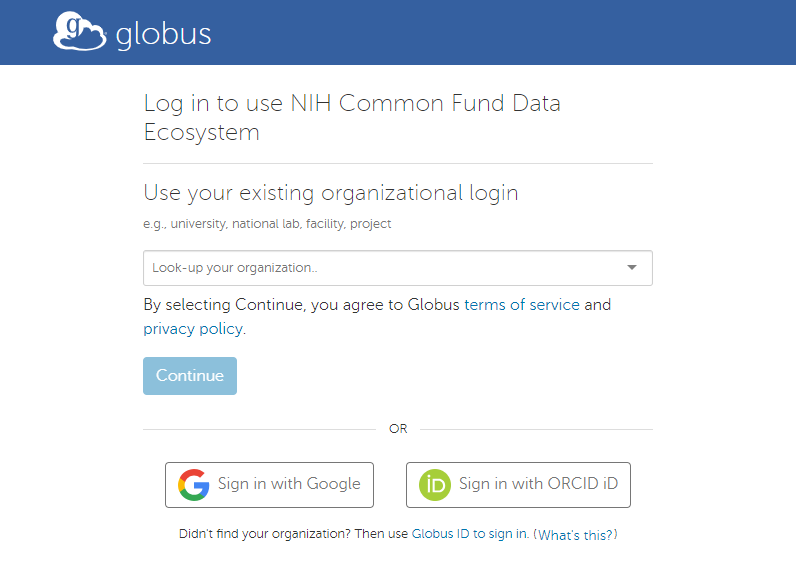
-
Search for your organization using the drop-down and sign in using Google, ORCID, or NIH Researcher Auth Service (RAS). Logging in using RAS with your NIH credentials is helpful if you want to view the dbGaP Study ID permissions in the File data browser.
a. If you do not see your organization in the drop-down, then click Sign in with ORCID ID to create a Globus account. A warning message displays.

b. Click Allow.
c. Enter your information and click Login.
-
If this is your first time logging in after November 1, 2021, the Sign up for Personalized Dashboard Features page displays.

-
Click Sign Up to be added to the NIH CFDE Portal Members group so you can view the personalized dashboard features. If you click Proceed before being added to the group, you will be returned to the portal Home page without being logged in. The Join Group page displays:
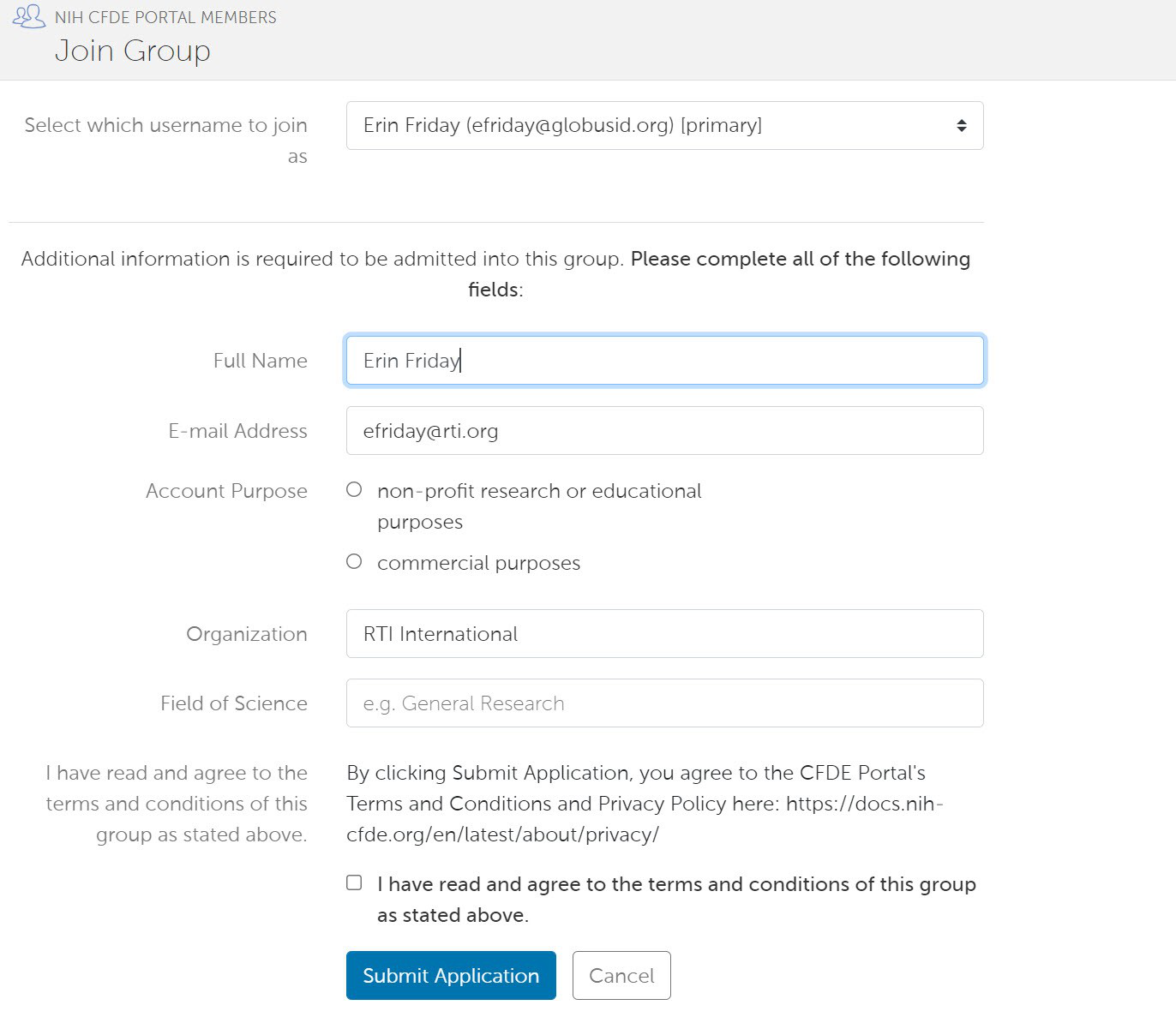
-
Enter your information and click Submit Application.
- Return to the Sign up for Personalized Dashboard Features page (in Step 3 above) and click Proceed. You will be logged in and see your personalized dashboard.
View Your Profile¶
Select your name in the upper-right after logging in, click the down arrow, and select My Profile. Your user profile information displays along with the saved searches and favorites from your personalized dashboard. Click “Add Record” in a gray menu bar to manually add a favorite.
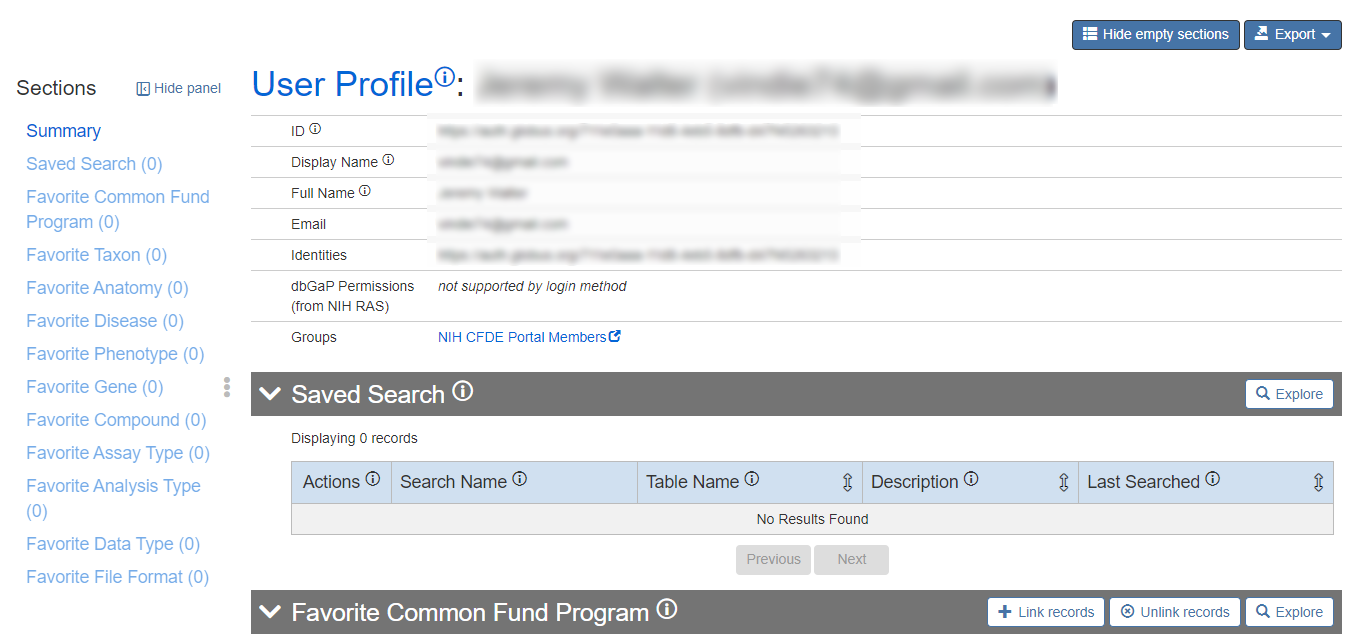
View and Create Your Personal Collections¶
Personal Collections are customized collections of files. From this page, you can customize your personal collections, view the files, and export them.
NOTE: A file must have a defined persistent ID before it can be added to your personal collection.
To view and create your personal collection: 1. Select your name in the upper-right after logging in, click the down arrow, and select Personal Collections. The Personal Collection page displays.

- Use the View Details, Edit, and Delete icons in the Actions column to view and modify an existing collection.
-
Click Create to create a new collection. The Create New Personal Collection page displays.

-
Enter the Name and the Description of the collection.
-
Click Save. A summary of the new collection displays.
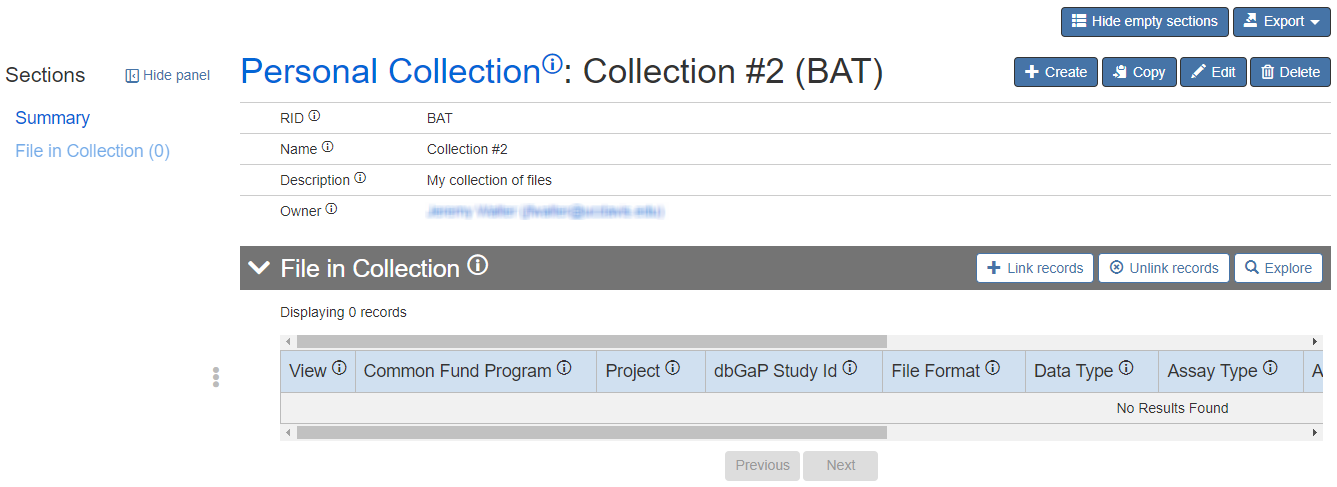
-
In the File in Collection section, click +Link records.
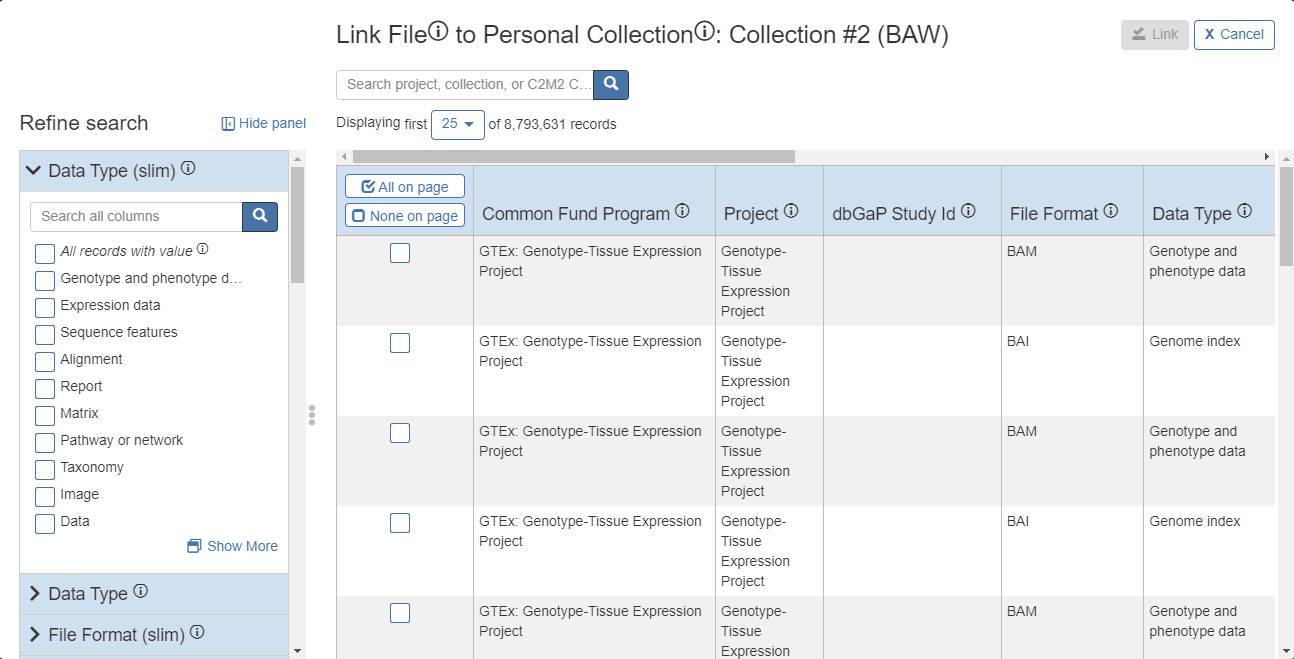
-
Select the checkboxes next to the files to add to your collection. Use the Refine search filter panel on the left or the search box in the upper-left to locate specific files.
- Click Link. The files are now associated with your personal collection and the collection displays as a separate line item on the Personal Collection page.
- If necessary, select Export > File Manifest in the upper-right of the collection (you can also access a collection by clicking the View Details icon on the Personal Collection page) to export the file details in CSV format. The CSV export consists of metadata where the Persistent ID is a path to where the file is hosted/stored. An NCPI (NIH Cloud Platform Interoperability) manifest file includes file details regarding the NCPI, which is an effort by the NIH to convene around interoperation for cloud workbenches.
To add a file to a collection from the Data Browser: 1. Select Data Browser > File from the main menu. 2. Search for the appropriate file. Ensure the “Has Persistent ID” facet is set to “True” since files in personal collections must have a defined Persistent ID. 3. Click View Details next to the appropriate file. The file details display.

-
In the Part of Personal Collection section, click +Link records. The Link Personal Collection to File page displays.

-
Select the checkbox next to the appropriate collection to which to add the file. Click Link. The file is added to the personal collection and the details on the Personal Collection page updates automatically.
Portal¶
The CFDE portal is a hub for searching the CFDE data across all programs. The main page of the portal (shown below) is meant for high-level decision-making, whereas the repository (or “data browser”) allows users such as clinical researchers, bioinformatics power users, and NIH program officers to search for CFDE data.
From the portal, you can:
- View and export a dashboard bar chart.
- Explore the repository of Common Fund data.
- Access the full dashboard with additional summary charts.
- Read documentation about the C2M2 and FAIR Cookbook.
- See the latest news regarding the CFDE.
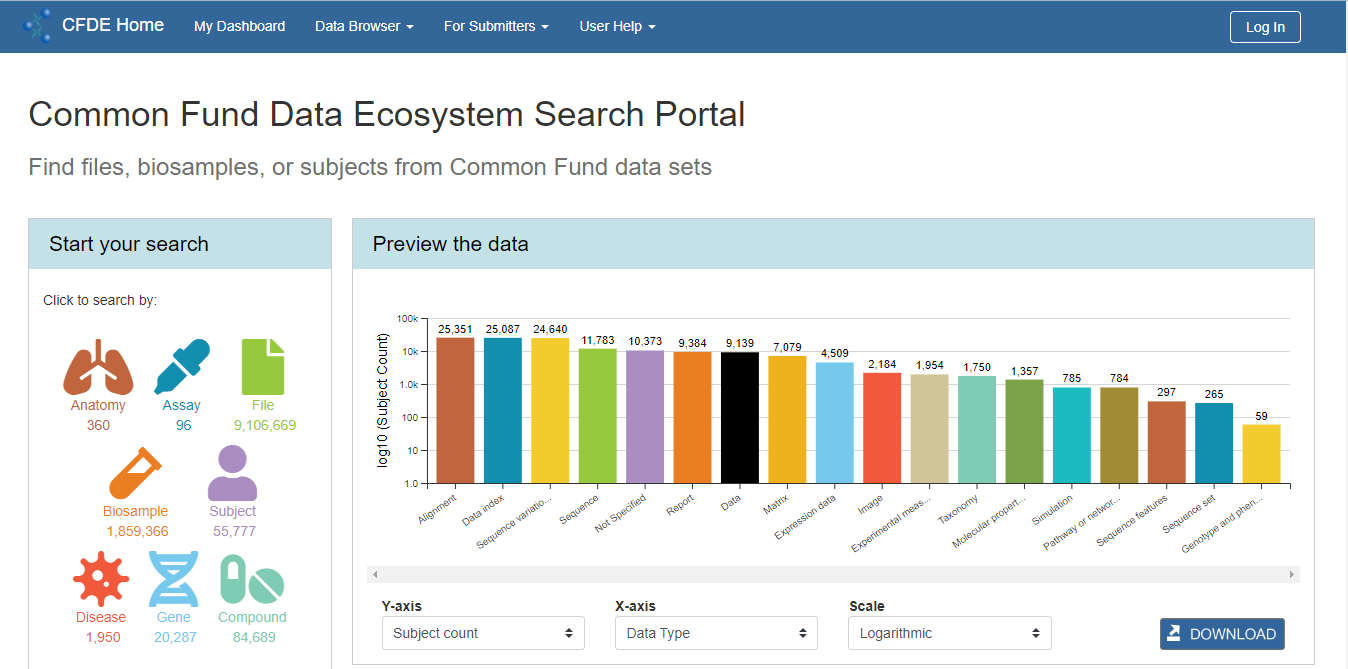
Access the Portal¶
Access the portal directly by using this link: https://app.nih-cfde.org/.
Filter the Chart¶
The portal chart is an interactive graphic that renders automatically when different criteria are selected from the Y-axis, X-axis, and Scale drop-downs. For example, the chart below shows the number of files by assay for each data type.
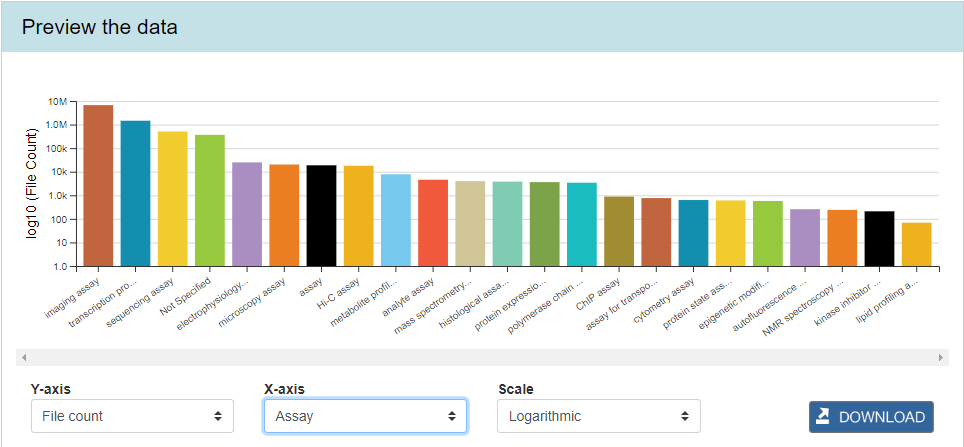
To filter the portal chart:
-
Select a Y-axis value from the drop-down. Options include:
- Data Volume
- Collection Count
- File Count
- Sample Count
- Subject Count
The vertical axis of the bar chart updates automatically with the option selected.
-
Select an X-axis value from the drop-down. Options include:
- Anatomy
- Assay
- CF Program
- Data Type
- Disease
- Ethnicity
- Race
- Sex
- Species
The horizontal axis of the bar chart updates automatically with the option selected.
-
Select a Scale value from the drop-down. Options include:
- Logarithmic
- Linear
The bars are stacked/sorted automatically with the option selected and the color-coded key updates with the appropriate categories.
Download the Chart¶
The Download icon ( ) displays next to each chart to export the data as a PNG, SVG, or CSV file. The PNG and SVG exports are image files of the chart, whereas the CSV export is a spreadsheet of the data.
) displays next to each chart to export the data as a PNG, SVG, or CSV file. The PNG and SVG exports are image files of the chart, whereas the CSV export is a spreadsheet of the data.
Explore the Repository¶
The CFDE repository, referred to as the “data browser,” provides views of the data based on the underlying data model and annotations. Using the data browser, you can:
- Search, explore, and browse collections of data
- Navigate from one data record to the next by following their relationships
- Explore and export data collections
- Share data with other users and cite the data for use in publications
The portal includes multiple ways to access the repository so you can view the data differently. For example, under the Data Browser menu, you can select “Collection” to see the entire CFDE data collection or select “Biosample” to see the data automatically pre-filtered by biosample. The data that displays and the Refine Search options differ based on the option selected.
The repository can be accessed in the following ways from the portal:
- Click an icon on the CFDE Home page under Start your Search to display a pre-filtered repository by one of the following features:
- Anatomy – See the Browse by Vocabulary section below for more information.
- Assay – See the Browse by Vocabulary section below for more information.
- File – See the Browse by File section below for more information.
- Biosample – See the Browse by Biosample section below for more information.
- Subject – See the Browse by Subject section below for more information.
- Disease - See the Browse by Vocabulary section below for more information.
- Gene - See the Browse by Vocabulary section below for more information.
- Compound - See the Browse by Vocabulary section below for more information.
- Select Data Browser > Collection from the main menu bar. See the Browse All Collections section below for more information.
- Select Data Browser > Project from the main menu bar. See the Browse by Project section below for more information.
- Select Data Browser > Primary DCC Contact from the main menu bar. See the Browse by Primary DCC Contact section below for more information.
- Select Data Browser > Vocabulary from the main menu bar and select an item from the list. See the Browse by Vocabulary section below for more information.
- Select Data Browser > ID Namespace from the main menu bar. See the Browse by ID Namespace section below for more information.
Browse All Collections¶
To search by all collections:
-
Select Data Browser > Collection from the main menu bar.
The entire CFDE data collection displays in the data browser.

-
The data browser includes the following columns in the results table:
- View – Click the icon next to the appropriate record to view more information about the record. See the View Details section for more information.
- Common Fund Program – The Common Fund program that defines the collection.
- Project – The project that defines the collection.
- Disease - The disease studied in the collection.
- Phenotype - The phenotype studied in the collection.
- Name – A short user-friendly label for the collection.
- Description – A user-friendly description of the collection.
- Creation Time – The date and time the collection was created.
-
The results can be filtered using the Refine Search filter panel. See the Refine Search Results section for more information. The panel includes the following facets by which you can filter the results:
- Data Type (slim)
- Data Type
- File Format (slim)
- File Format
- Assay Type (slim)
- Assay Type
- Sample Prep Method
- Anatomy (slim)
- Anatomy
- Taxonomy (slim)
- Taxonomy
- Disease (slim)
- Disease
- Compound
- Protein
- Gene
- Phenotype
- Common Fund Program
- Project
- Subject Granularity
- Has Time Series Data
- Collection Creation Time
Browse by File¶
To search by file:
-
Select one of the following options:
- The Data Browser > File option in the main menu bar.
- The File link under View Data By in the Start your Search section on the main portal page.
The data browser displays the CFDE data and filters related to files.
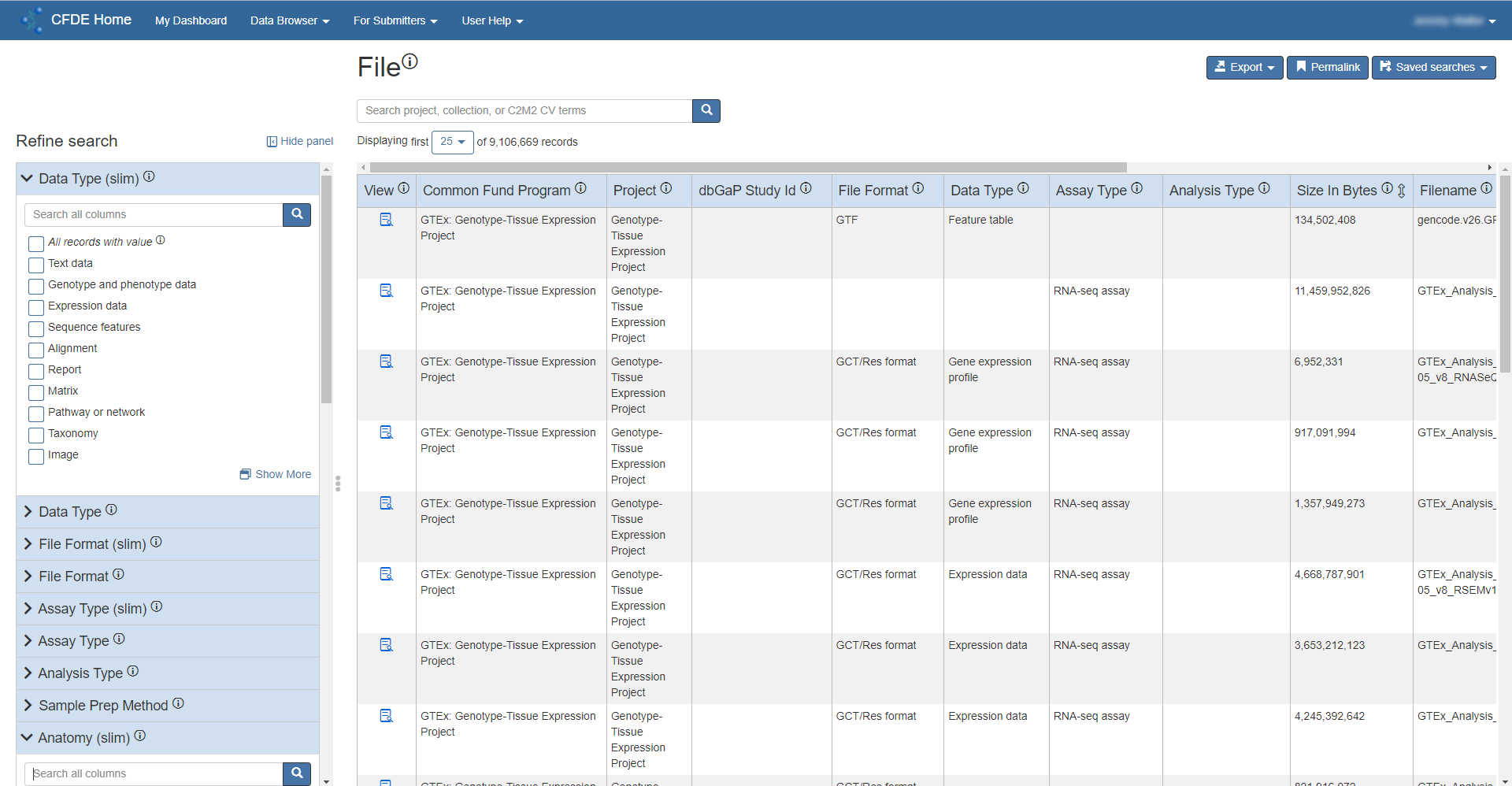
-
The data browser includes the following columns in the results table:
- View – Click the icon next to the appropriate record to view more information about the record. See the View Details section for more information.
- Common Fund Program – The Common Fund program that defines the file.
- Project – The project attributed as the source of the file.
- dbGaP Study ID - The RAS permissions for files are indicated by a green circle (user has access to the file), a yellow circle (user does not have access to the file), or a gray circle (user access to the file cannot be determined).
- File Format – The content format of the file.
- Data Type – The type of data represented by the file.
- Assay Type – The assay type represented by the file.
- Analysis Type - The analysis type used to generate the file.
- Size in Bytes – The size of the file in bytes.
- Filename – The name of the file excluding prepended PATH information.
- Persistent ID – A persistent, resolvable URI generated by a DCC and attached to the file.
- Creation Time – The date and time the file was created.
- The results can be filtered using the Refine Search filter panel. See the Refine Search Results section for more information. The panel includes the following facets by which you can filter the results:
- Data Type (slim)
- Data Type
- File Format (slim)
- File Format
- Assay Type (slim)
- Assay Type
- Analysis Type
- Sample Prep Method
- Anatomy (slim)
- Anatomy
- Subject Taxonomy (slim)
- Subject Taxonomy
- Disease (slim)
- Disease
- Phenotype
- Compound
- Gene
- Age at Sampling
- Sex
- Race
- Ethnicity
- Age at Enrollment
- dbGaP Study ID
- Common Fund Program
- Project
- Subject Granularity
- File Creation Time
- Size in Bytes
- Has Persistent ID
- Is Bundle
- Uncompressed Size in Bytes
- Compression Format
Browse by Biosample¶
To search by biosample:
-
Select one of the following options:
- The Data Browser > Biosample option in the main menu bar.
- The Biosample link under View Data By in the Start your Search section on the main portal page.
The data browser displays the CFDE data and filters related to biosamples.
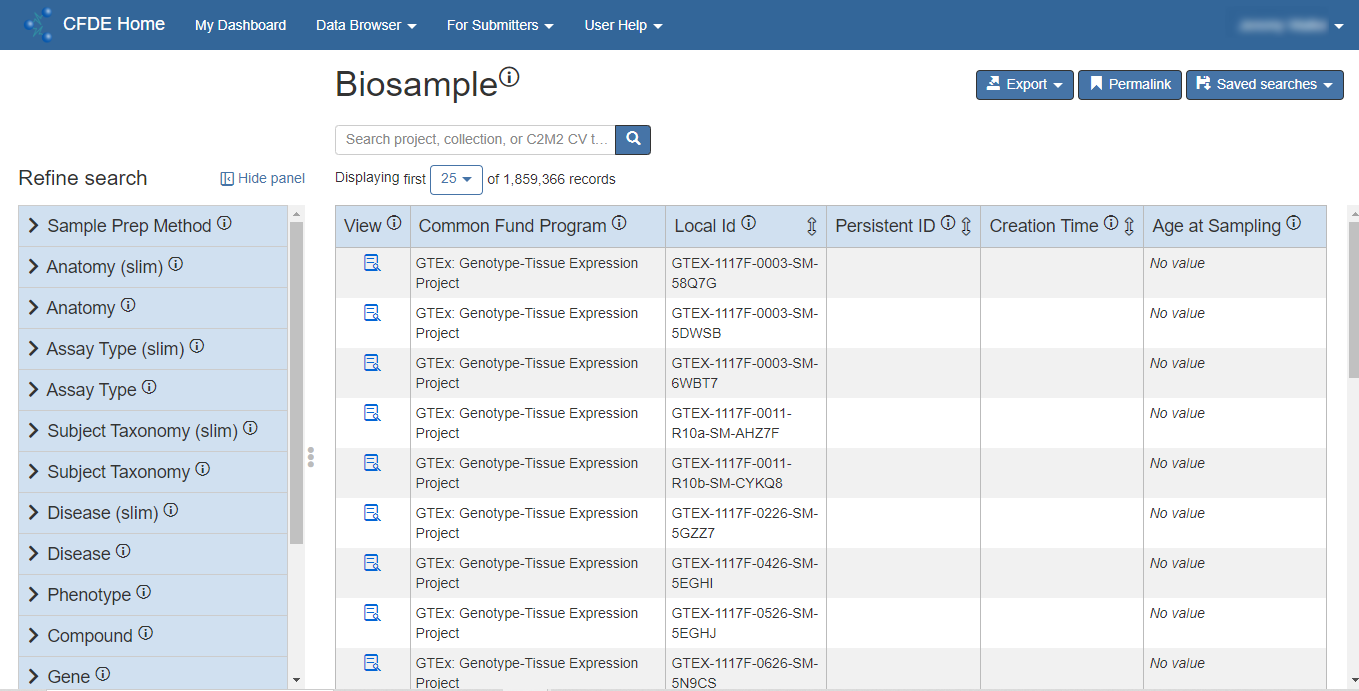
-
The data browser includes the following columns in the results table:
- View – Click the icon next to the appropriate record to view more information about the record. See the View Details section for more information.
- Common Fund Program – The Common Fund program that defines the biosample.
- Local ID – The unique biosample ID within the ID Namespace.
- Persistent ID – A persistent, resolvable URI generated by a DCC and attached to the file.
- Creation Time – The date and time the biosample was created.
- Age at Sampling – The subject's age, in years, when the biosample was taken.
- The results can be filtered using the Refine Search filter panel. See the
Refine Search Results section for more information. The panel includes the following facets by which you can filter the results:
- Sample Prep Method
- Anatomy (slim)
- Anatomy
- Assay Type (slim)
- Assay Type
- Subject Taxonomy (slim)
- Subject Taxonomy
- Disease (slim)
- Disease
- Phenotype
- Compound
- Gene
- Common Fund Program
- Project
- Creation Time
- Age at Sampling
Browse by Subject¶
To search by subject:
-
Select one of the following options:
- The Data Browser > Subject option in the main menu bar.
- The Subject link under View Data By in the Start your Search section on the main portal page.
The data browser displays the CFDE data and filters related to subjects.
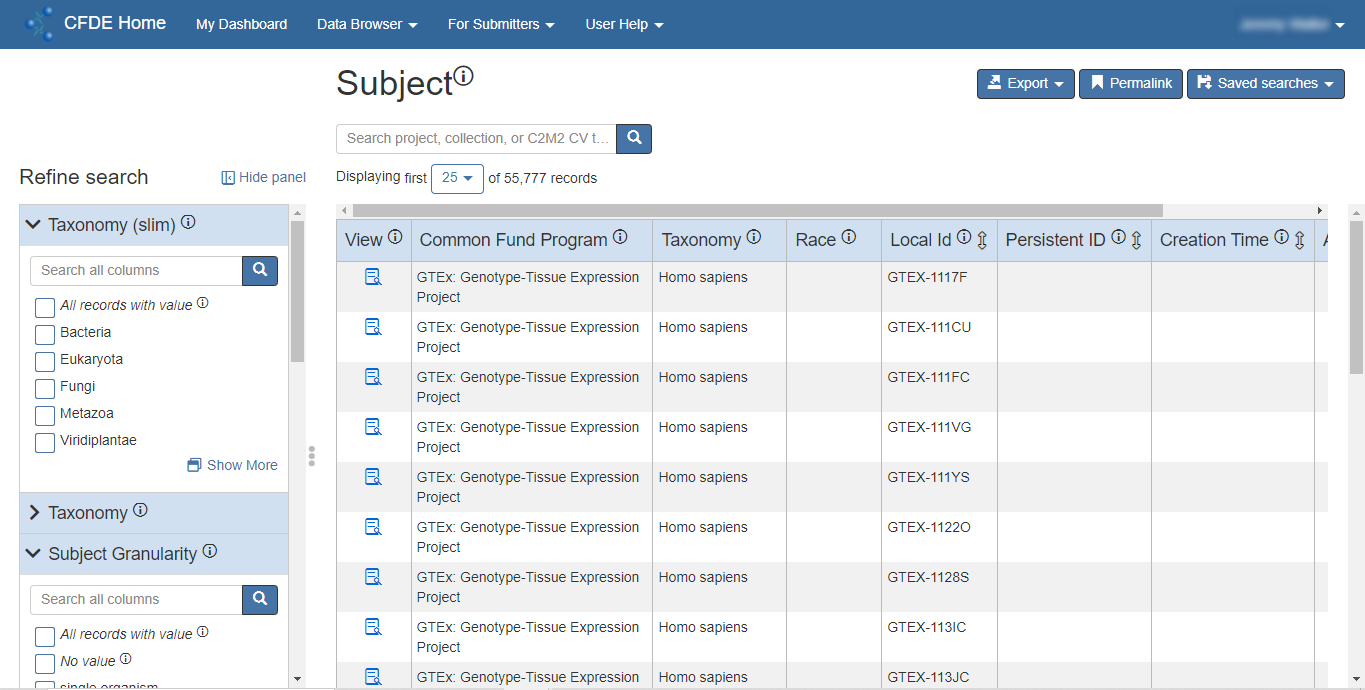
-
The data browser includes the following columns in the results table:
- View – Click the icon next to the appropriate record to view more information about the record. See the View Details section for more information.
- Common Fund Program – The Common Fund program that defines the subject.
- Taxonomy – The taxonomy concepts that characterize the subject.
- Race – The race characterizing the subject.
- Local ID – The unique subject ID within the ID Namespace.
- Persistent ID – A persistent, resolvable URI generated by a DCC and attached to the file.
- Creation Time – The date and time the subject record was created.
- Age at Enrollment – The age, in years, of the subject when they were first enrolled in the project in which they were studied.
- The results can be filtered using the Refine Search filter panel. See the
Refine Search Results section for more information. The panel includes the following facets by which you can filter the results:
- Taxonomy (slim)
- Taxonomy
- Subject Granularity
- Sex
- Race
- Ethnicity
- Disease (slim)
- Disease
- Phenotype
- Compound
- Gene
- Taxonomic Role
- Anatomy (slim)
- Anatomy
- Sample Prep Method
- Assay Type (slim)
- Assay Type
- Data Type (slim)
- Data Type
- File Format (slim)
- File Format
- Common Fund Program
- Project
- Creation Time
- Age at Enrollment
Browse by Project¶
To search by project:
-
Select Browse All Data > Project from the main menu bar. The data browser displays the CFDE data and filters related to projects.

-
The data browser includes the following columns in the results table:
- View – Click the icon next to the appropriate record to view more information about the record. See the View Details section for more information.
- Common Fund Program – The Common Fund program that defines the project.
- Name – A short user-friendly label for the project.
- Description – A user-friendly description of the project.
- Creation Time – The date and time the project was created.
- The results can be filtered using the Refine Search filter panel. See the
Refine Search Results section for more information. The panel includes the following facets by which you can filter the results:
- Creation Time
- Common Fund Program
- Assay Type
- Data Type
- File Format
- Anatomy (slim)
- Anatomy
- Subject Taxonomy
- Disease
- Super-Project
- Sub-Project
Browse by Common Fund Program¶
To search by primary DCC contact:
- Select Data Browser > Common Fund Program from the main menu bar. The data browser displays the CFDE data and filters related to the Common Fund Programs.
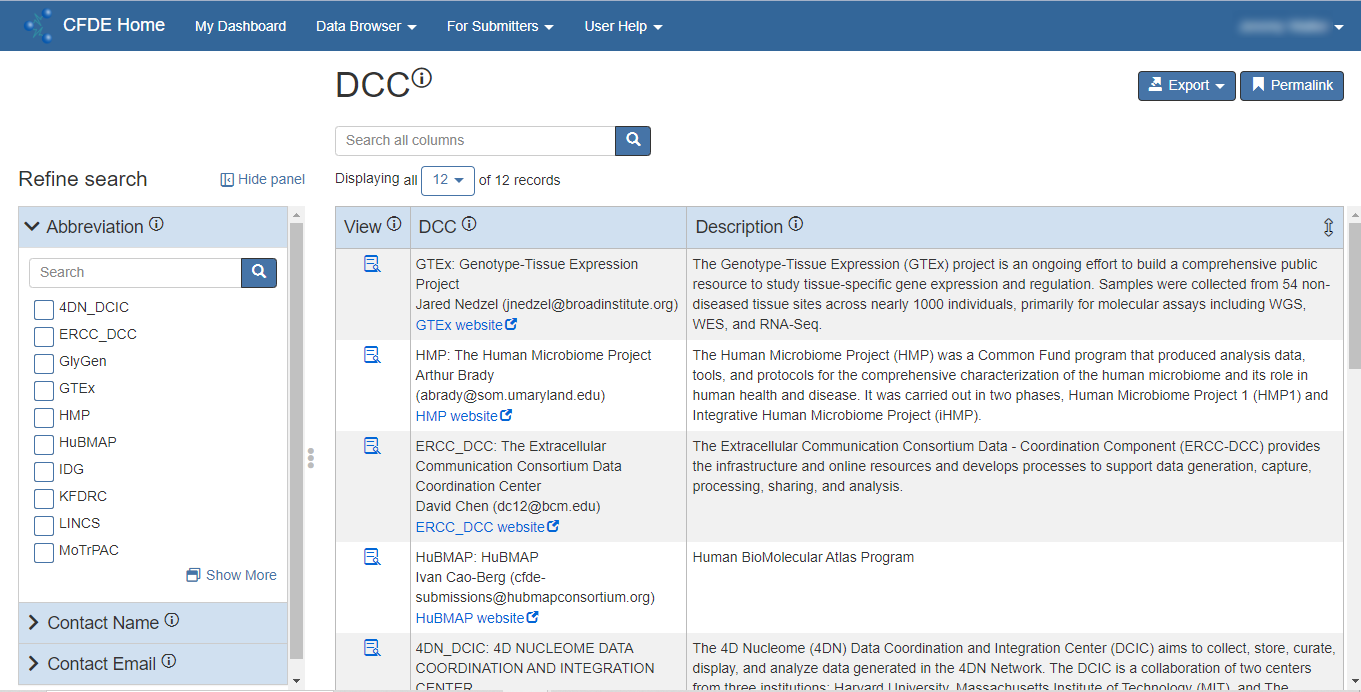
- The data browser includes the following columns in the results table:
- View – Click the icon next to the appropriate record to view more information about the record. See the View Details section for more information.
- DCC – Contact information about the Data Collection Center (DCC).
- Description – A user-friendly description of the DCC.
- The results can be filtered using the Refine Search filter panel. See the
Refine Search Results section for more information. The panel includes the following facets by which you can filter the results:
- Abbreviation
- Contact Name
- Contact Email
Browse by Vocabulary¶
To search by vocabulary:
- Select Data Browser > Vocabulary from the main menu bar.
-
Select an item from the list:
- Analysis Type
- Anatomy
- Assay Type
- Compound
- Data Type
- dbGaP Study ID
- Disease
- Ethnicity
- File Format
- Gene
- MIME Type
- NCBI Taxonomy
- Phenotype
- Protein
- Race
- Sample Prep Method
- Sex
- Subject Granularity
- Subject Role
- Substance
The data browser displays the CFDE data and filters related to the vocabulary term.
-
The columns vary based on the vocabulary term selected.
- The available filters in the Refine Search panel vary based on the vocabulary term selected. See the Refine Search Results section for more information on how to filter the results.
Browse by ID Namespace¶
To search by ID namespace:
-
Select Data Browser > ID Namespace from the main menu bar.
The data browser displays the CFDE data and filters related to the ID namespace data contributors.
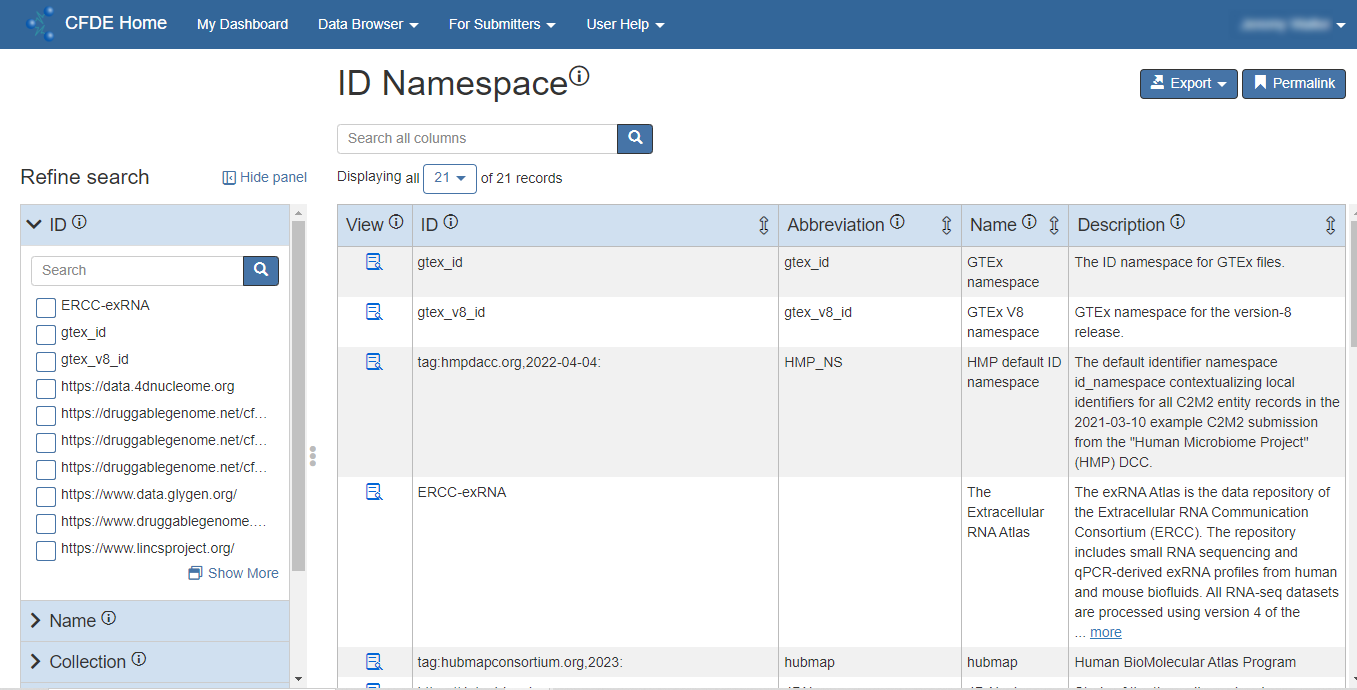
-
The data browser includes the following columns in the results table:
- View – Click the icon next to the appropriate record to view more information about the record. See the View Details section for more information.
- ID – The unique ID within the ID Namespace.
- Abbreviation – A short label for the ID Namespace.
- Name – A short user-friendly label for the ID Namespace.
- Description – A user-friendly description of the ID Namespace.
-
The results can be filtered using the Refine Search filter panel. See the Refine Search Results section for more information. The panel includes the following facets by which you can filter the results:
- ID
- Name
- Collection
- File
- Biosample
- Subject
View Details¶
Click the icon in the View column ( ) next to the appropriate record in the results table to view more information about the record, such as the metadata and links to the data files for that record. The options available on the View Details page vary based on the record selected, but this section of the document will use the screenshot below as an example.
) next to the appropriate record in the results table to view more information about the record, such as the metadata and links to the data files for that record. The options available on the View Details page vary based on the record selected, but this section of the document will use the screenshot below as an example.
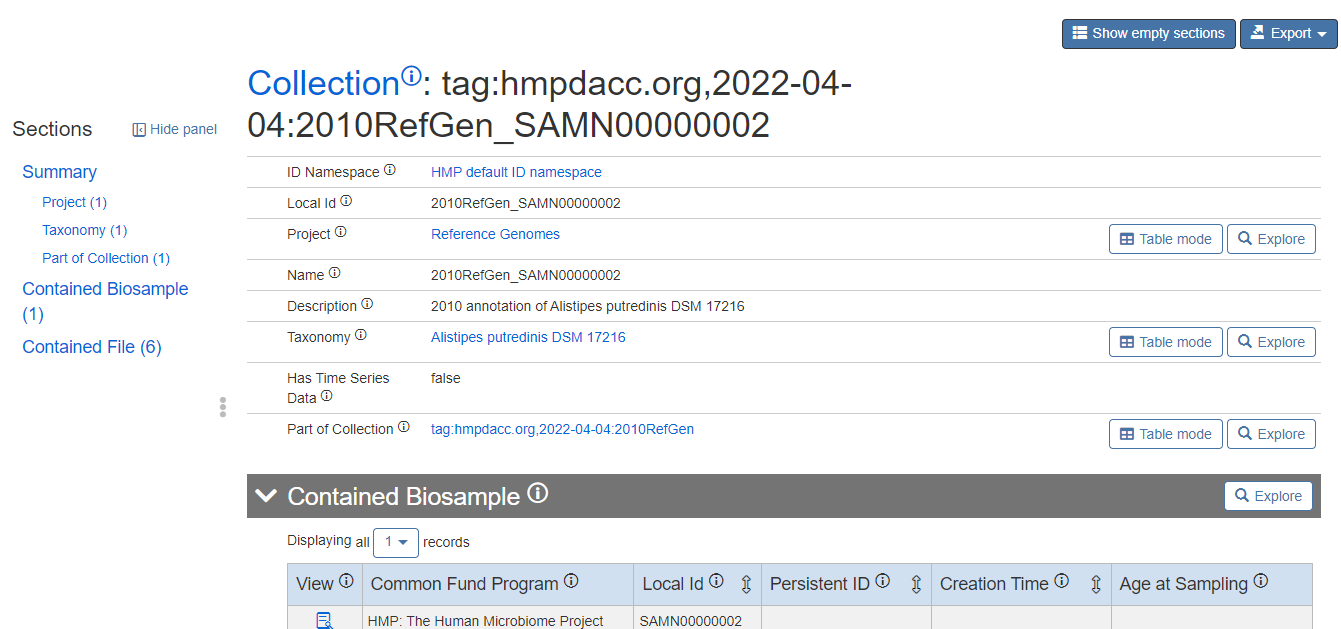
The metadata displays in the summary section at the top of the page. In the example above, the metadata includes:
- ID Namespace – The hyperlink will display a View Details page for the Genotype-Tissue Expression ID Namespace.
- ID – The unique ID within the ID Namespace.
- Persistent ID – An identifier that provides a single view of an individual across numerous devices (desktop, mobile, in-app, etc.) without duplication.
- Defined by Project – The hyperlink will display the Genotype-Tissue Expression (GTEx) project in a separate data browser.
- Click Table Mode to display the project in a table with additional information.
- Click Explore to open the project in a separate data browser.

- Name – A short user-friendly label for the ID Namespace.
- Description – A user-friendly description of the ID Namespace.
- Creation Time – The date and time the project was created.
The anatomy, compound, disease, gene, and protein pages are now annotated with images, interactive widgets, aliases, associations, and links to databases. For example, the View Details page for an Anatomy file:

The Sections panel on the left displays links to the contents of the View Details page (similar to a Table of Contents) and the counts for each section. Click one of the links to jump to that section of the View Details page. You can also scroll down the page to view the sections instead of using these links.
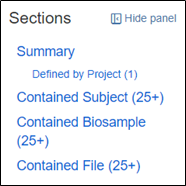
Click Explore in the gray section header to open the section in a separate data browser, where you can use the Refine Search filter panel to refine your search.

Within each data file, you can click the View icon to view additional information about the record.
The buttons in the upper-right of the page include:
- Show/Hide empty sections - Toggles the empty sections that display on this page.
- Export – See the Export Search Results section for more information.
Refine Search Results¶
To use the facets to refine your search results:
-
Click the down arrow next to the appropriate facet to display the related attributes by which you can filter the results.

-
Within a facet, you can perform any of the following to filter the results:
- Select the appropriate attribute checkbox(es).
- Use the Search box to search for attributes only within that facet.
- Click Show More to display additional information about the attributes.
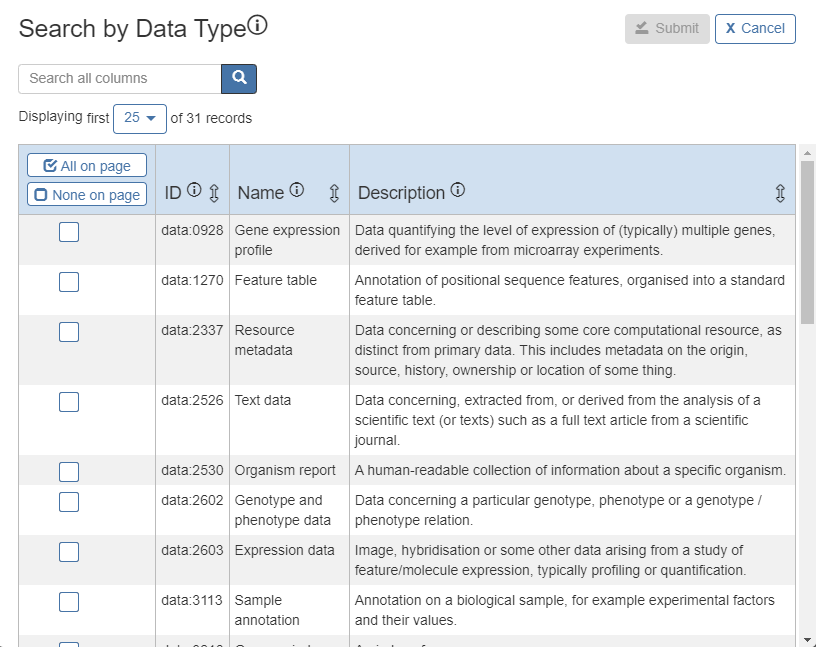
-
The time-related facets (Collection Creation Time, File Creation Time, and Biosample Creation Time) and the Size in Bytes facet function differently. To filter on a time-related facet, perform one of the following:
- Enter the From and To dates and times. Click the blue checkmark to filter the results in the main data browser.
- Use the interactive histogram to find the appropriate time period. Click and drag anywhere in the graph to zoom into a smaller subset of data. The From and To dates update automatically as you use the histogram, but you must select the blue checkmark to filter the results in the main data browser.
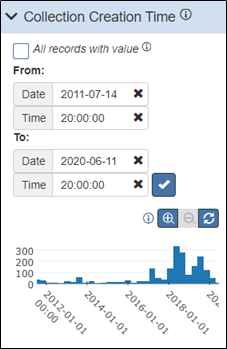
Sort and View Search Results¶
The data browser search results can be sorted and viewed using the following functions:
- The results table can be sorted by column header using the arrow icon (
 ).
). - View a different amount of results on one page by selecting a different option for the Displaying first number of records drop-down.

- Use the Search All Columns search box at the top of the results table to search for records within the table. The search box may include other terms such as 'collection' or 'project' depending on the search criteria.

- View additional results by clicking the Next button at the bottom of the table.
- Click the X next to the filter to remove the one filter from the search results.

- Click Clear All Filters to remove all filters from the search results.
Export Search Results¶
Search results can be exported from the data browser when viewing the core C2M2 tables. The collection, file, biosample, and subject tables show Collection BDBAG, File BDBAG, Biosample BDBAG, and Subject BDBAG export options, respectively. The file table adds an NCPI file manifest option not applicable to the other C2M2 tables.
The various BDBAG options produce a so-called Big-Data Bag which is a zipfile with multiple, CSV-formatted tabular data files and other supporting metadata. Generally, the CSV file content will have columns following the C2M2 model specification. When run on a search page with paginated results, the export will represent all matching results for the search criteria. When run on a single (detailed) record page, the export will represent that single record as the main result. There will be a CSV file representing the main record(s) as well as other CSV files representing related content from other C2M2 tables.
The personal collection feature mimics the same export options as the C2M2 file table. However, export is only offered from each detailed personal collection page. This page represents a manually curated set of file records, and so produces exports as if a search were performed with this specific set of matching files.
-
Click the Export button.

-
Select CSV, BDBAG, or NCPI file manifest. The options that display will depend on which page you are on:
- CSV – Opens a .csv file in Excel that includes the metadata displayed in the search results in tabular format.
- BDBAG – Downloads the data to a .bag file used for storing ROS message data. Use this option if you want to download large files or if a particular dataset includes many files.
- NCPI file manifest - for File exports. This option exports the BDBAG data plus the actual files associated with the record pages. The file includes the DRS_URI that includes a link to the file information. Note that the file must have a Persistent ID to view the DRS_URI.
Save Searches¶
On any data browser page, you can save searches and easily return to them later through your personalized dashboard.
To save a search:
1. Select Saved Searches > Save current search criteria from the upper-right of the page.
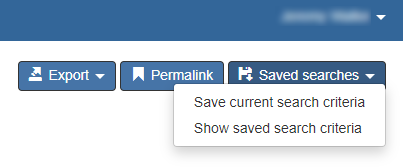
The Save Current Search Criteria pop-up displays.
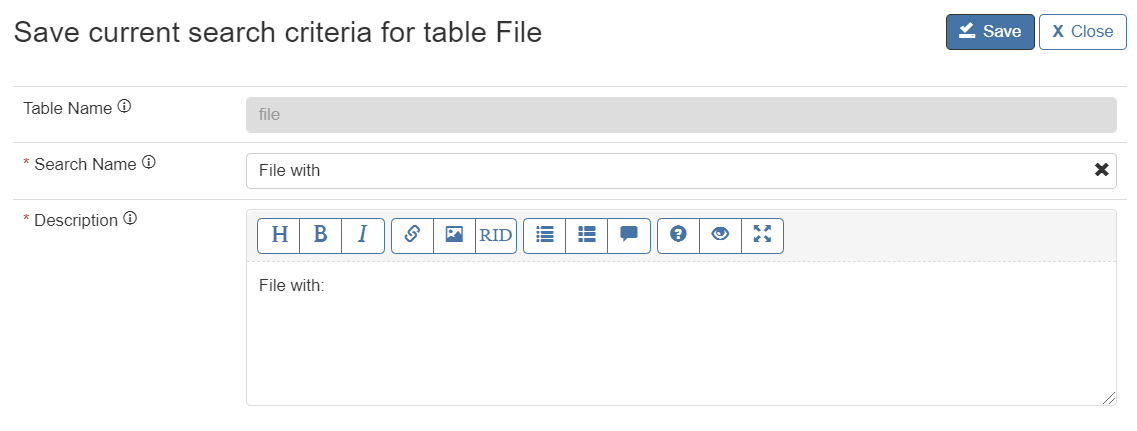
- Enter a Query Name for your saved search. This displays as the Search Name on your personalized dashboard.
- Enter a Description for your saved search. This displays when you hover over the Search Name on your personalized dashboard.
- Click Save.
To view saved search criteria: 1. Select Saved Searches > Show saved search criteria from the upper-right of the page. The Saved Search Criteria for Table pop-up displays the saved searches related only to that repository.

If no saved searches exist for that repository, then this pop-up will not display any results.
Add Favorites¶
On any data browser page, you can save favorites for vocabulary items and easily return to them later through your personalized dashboard. Currently, the favorites that display on your dashboard are items under the CF Programs, Anatomy, Assay, Disease, Taxonomy, Data Type, File Format, Gene, and Compound facets in the Refine Search filter panel.
To add a favorite: 1. Click the star icon next to the item you want to favorite in the Refine Search filter panel to the left of the data browser.
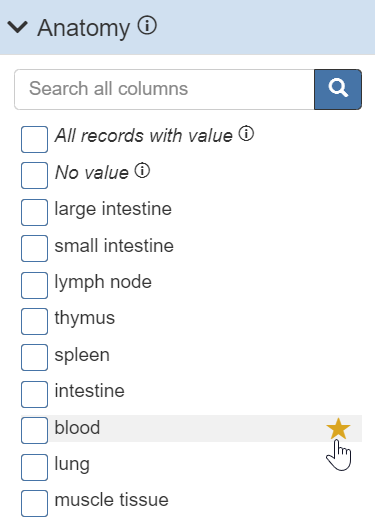
- The star will turn yellow to indicate it is a favorite for all data browser searches and your dashboard will be immediately updated.
User Help¶
To access additional CFDE resources, select User Help from the main menu bar. The following resources are available:
- Contact the Help Desk to send an email to [email protected] using your default email application.
- Portal User Guide opens this guide.
- Video Overviews about using CFDE tools for data integration, information on FAIR principles, and cross-cutting discovery use cases.
- Tutorials includes use cases and tutorials related to CFDE cohorts.
- Submit a Feature Request or Bug Report opens GitHub where you can select “New Discussion” to ask a question.
- Privacy Policy includes additional information on the disclaimer of endorsement, terms and conditions, privacy policy, disclaimer of liability, and the CFDE cookie policy.
- About the CFDE includes information such as:
- The CFDE Crosscut Metadata Model (C2M2) is a flexible standard for describing biomedical experimental data.
- The FAIR Cookbook provides introductory materials about various aspects of FAIRness, including practical guides that show how to enhance digital objects by adhering them to communicated-accepted standards.
Dashboard¶
The CFDE dashboard includes: * A generic dashboard of high-level charts that are available without logging in. * A personalized dashboard that is available after logging in.
The CFDE dashboard displays multiple charts for users to view high-level data. The charts update automatically with the selections you make and the precise numbers can be viewed by hovering over the chart. The charts include:
- Bar chart of the subject count by Data Type and Common Fund Program. The Y-axis, X-axis, and Scale are configurable by all users to customize the data summary as needed.
- Bar chart of the file count by Common Fund Program and Assay. The Y-axis, X-axis, and Scale are configurable by all users to customize the data summary as needed.
- Pie chart of the number of subjects by assay and anatomy across all Common Fund programs configurable by assay.
- Pie chart of the number of samples by anatomy for a single Common Fund program configurable by program.
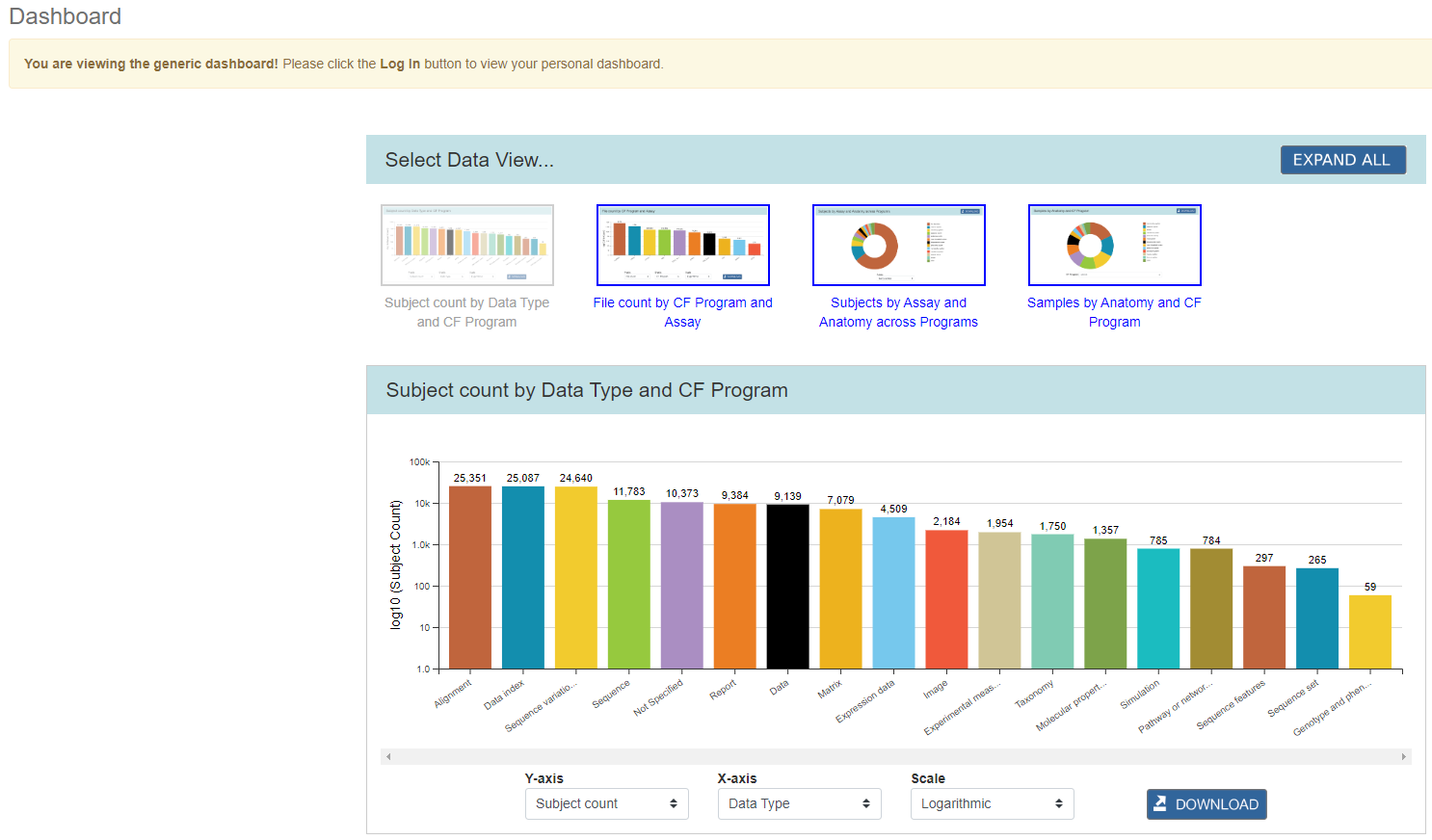
Access the Dashboard¶
To access the dashboard:
- Access the dashboard directly using this link: https://app.nih-cfde.org/dashboard.html
- Click My Dashboard in the main menu bar from the portal.
Navigate the Generic Dashboard¶
Filter the Bar Charts¶
The bar charts allow users to compare CFDE data by Anatomy, Assay, CF Program, Data Type, Disease, Ethnicity, Race, Sex, or Species using File Count, Data Volume, Collection Count, Sample Count, or Subject Count. The X-axis, Y-axis, and Scale are configurable by all users to customize the data summaries as needed.
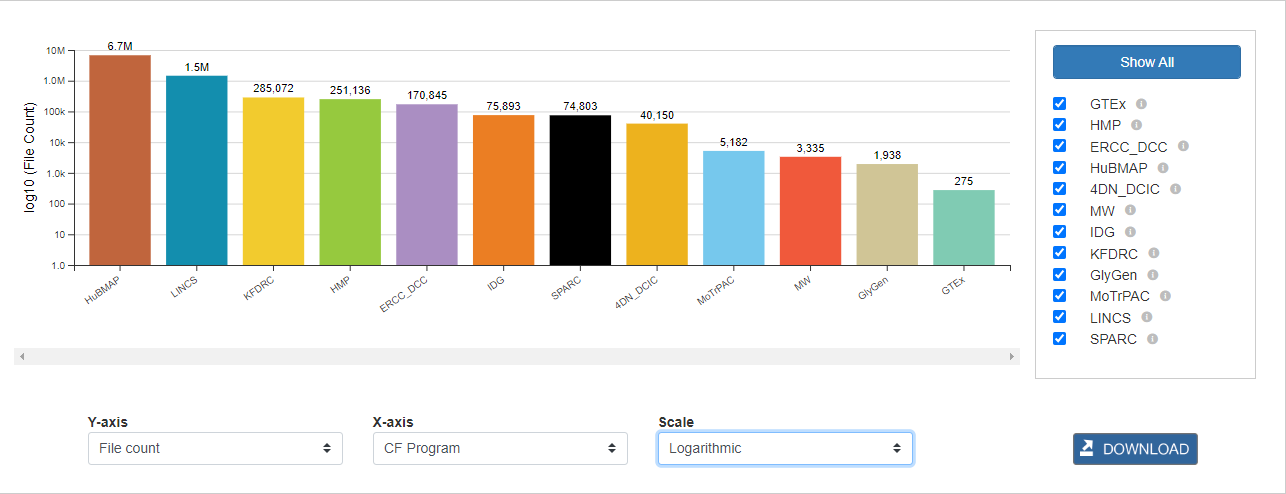
To filter the bar charts:
-
Select a Y-axis value from the drop-down. Options include:
- Subject Count
- Data Volume
- Collection Count
- File Count
- Sample Count
The vertical axis of the bar chart updates automatically with the option selected.
-
Select a X-axis value from the drop-down. Options include:
- Anatomy
- Assay
- CF Program
- Data Type
- Disease
- Ethnicity
- Race
- Sex
- Species
The horizontal axis of the bar chart updates automatically with the option selected.
-
Select a Scale option from the drop-down. Options include:
- Linear
- Logarithmic
Filter the Subjects by Assay and Anatomy across Programs Chart¶
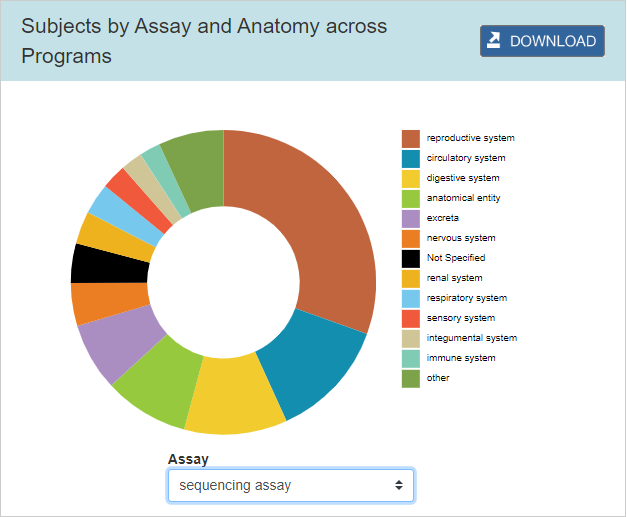
To filter the Subjects by Assay and Anatomy across Programs chart:
- Select the Assay Type from the drop-down. Options include:
- sequencing assay
- polymerase chain reaction assay
- transcription profiling assay
- imaging assay
- electrophysiology assay
- microscopy assay
- cytometry assay
- assay
- analyte assay
- histological assay
- metabolite profiling assay
- protein expression profiling assay
- lipid profiling assay
- kinase inhibitor assay
- other
The pie chart updates automatically and displays the number of subjects for each anatomy category (e.g., digestive system, renal system, nervous system, etc.) across all Common Fund programs based on the assay type selected.
Filter the Samples by Anatomy and CF Program Chart¶
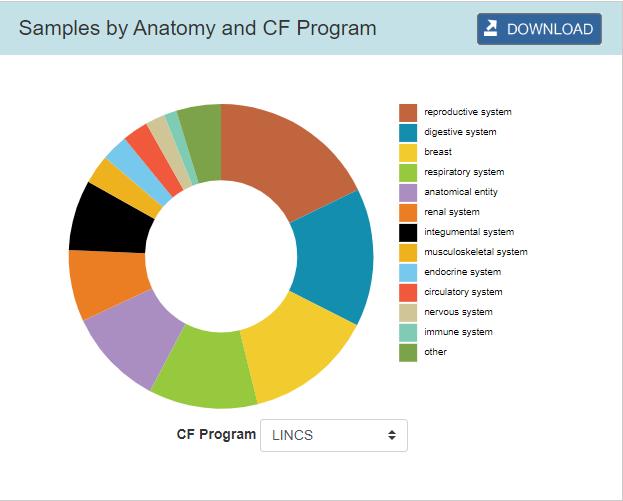
To filter the Samples by Anatomy and CF Program chart:
-
Select the CF Program from the drop-down. Options include:
- LINCS
- MW (Metabolomics Workbench)
- KFDRC (Kids First)
- HMP
- GTEx
- ERCC_DCC
- MoTrPAC
- SPARC
- 4DN_DCIC
- HuBMAP
The pie chart updates automatically and displays the number of samples for each anatomy category (reproductive system, throat, blood cell, etc.) based on the Common Fund program selected.
Download the Chart¶
The Download icon ( ) displays next to each chart to download the data as a PNG, SVG, or CSV file. The PNG and SVG exports are image files of the chart, whereas the CSV export is a spreadsheet of the data.
) displays next to each chart to download the data as a PNG, SVG, or CSV file. The PNG and SVG exports are image files of the chart, whereas the CSV export is a spreadsheet of the data.
Navigate the Personalized Dashboard¶
After logging in, you can view your personalized dashboard that includes saved searches and saved favorites for CF Programs, Anatomy, Assay, Disease, Taxonomy, Data Type, File Format, Gene, and Compound facets.

To populate the personalized dashboard: * Saved searches – Browse data under the Data Browser menu and select Saved Searches > Save current search criteria from the upper-right of the page. See the Save Searches section for more information. * Personal Collections - Browse files under the Data Browser menu and select Add Record under the Part of Personal Collection section. See the View and Create Your Personal Collections section for more information. * Favorites – Browse data under the Data Browser menu and select the star icon next to an item in the Refine Search filter panel facet. See the Add Favorites section for more information.
The bar chart can be filtered by DCC (the checkboxes on the right) and grouped by anatomy, assay, CF program, data type, disease, ethnicity, race, sex, or species (the Group By drop-down at the top). You can also change the y-axis and/or the x-axis to view the appropriate information.
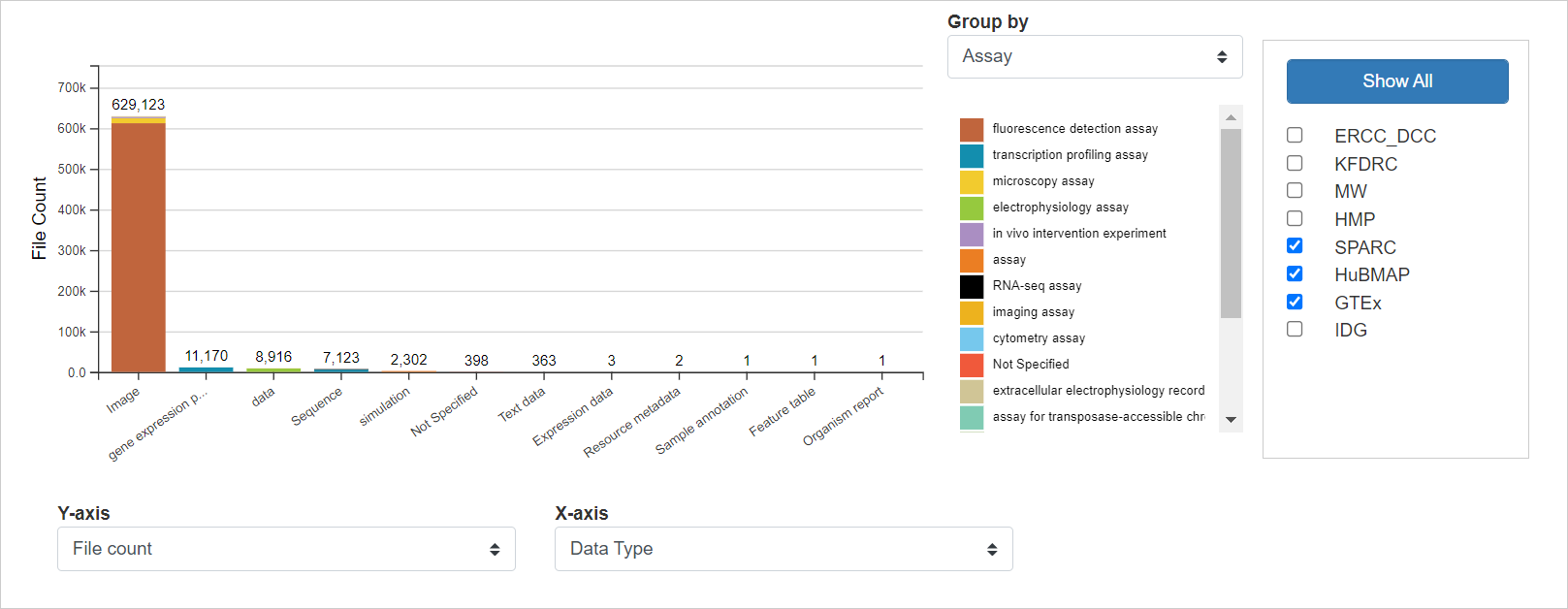
Below this bar chart are additional charts for Subjects by Assay and Anatomy across Programs and Samples by Anatomy and CF Program.
Data Review¶
The Data Review page displays the recent data submission that has not yet been incorporated into the main catalog. Data administrators should review the data to ensure it is correct before being incorporated into the portal. The DCC data that displays is based on the DCC associated with your login account.
To access the Data Review page, click Data Review in the main menu bar from the portal or dashboard.
The data review options under the Submission System menu bar include:
- Submitted Datapackages
- Enrolled DCCs
- Enrolled Groups
- Releases
- Vocabulary
Review Submitted Datapackages¶
To review the submitted datapackages:
-
Select one of the following options:
- The Data Review option in the main menu bar from the portal or dashboard.
- The Submission System > Submitted Datapackages option in the main menu bar of the Data Review system.
The Submitted Datapackage page displays.
-
The data browser includes the following columns in the results table:
- View
- Click the View icon next to the appropriate record to view more information about the record. See the View Details section for more information.
- For users with Approver permissions, an Edit (pencil) icon will display in this column as well. See the Approve Data section for more information.
- Submission – Displays additional identifying information about the submitted data, such as submission date, ID, the DCC, and the submitter.
- Status Summary – The ingest status (what is happening with your submission) and approval status of the datapackage in the submission system. When the ingest status is “content ready for review,” additional links for Browse Data, Summary Charts, and Raw Data display where you can review the submission. See the Review Content section for more information.
- View
- The results can be filtered using the Refine Search filter panel. See the Refine Search Results section for more information. The panel includes the following facets by which you can filter the results:
- Submitting DCC
- Submitting User
- Status
- DCC Approval
- CFDE Approval
- Submission Time
Review Content¶
On the Submitted Datapackages page, you can access additional information about a record in the “content ready for review” ingest status by selecting one of the following links in the Review Content section (under the Status Summary column):
- Browse Data – The File data browser displays with additional information for that record only. You can view additional details about the submission by selecting In-Review Submission > Submission
.
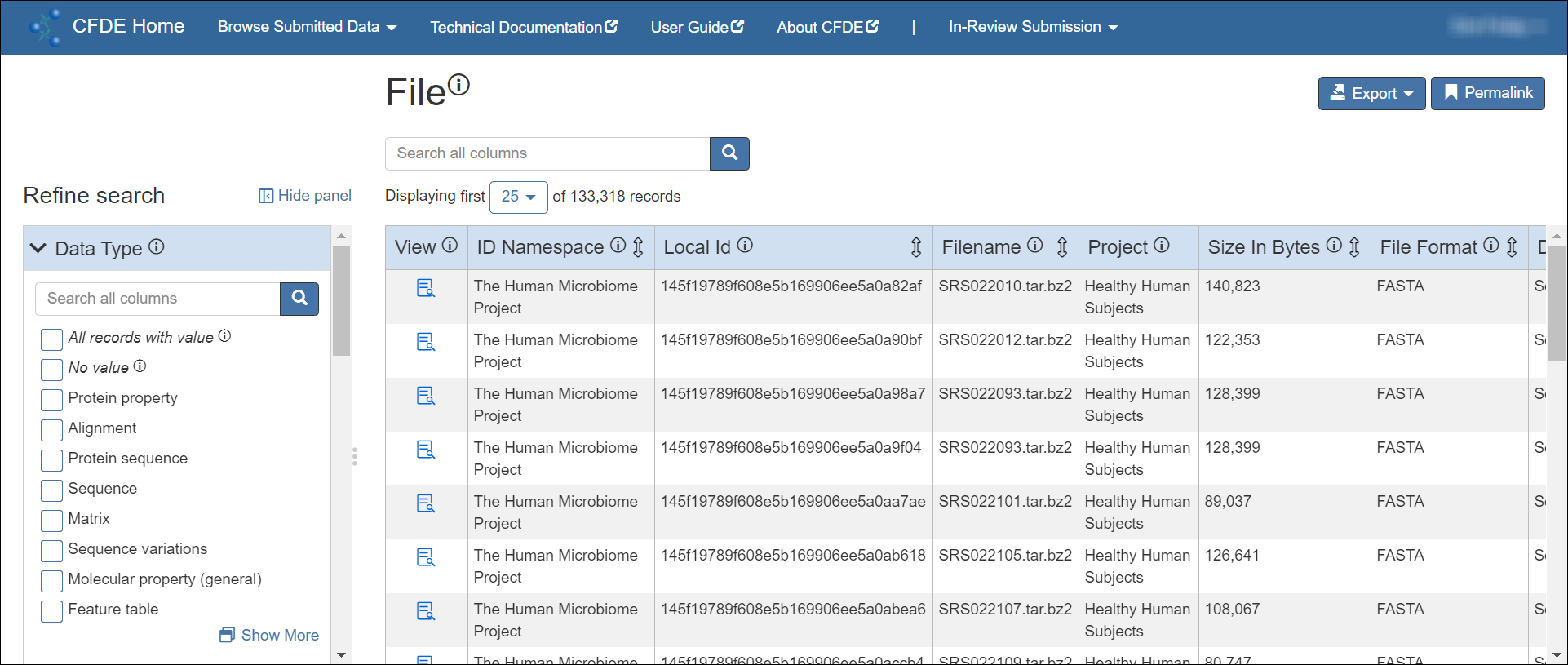
- Summary Charts – The dashboard displays with additional information for that record only. The hyperlinked totals will open data browsers with additional information about those numbers. You can also access this page from the Browse Data File data browser by selecting In-Review Submission > Content Summary Charts from the main menu.

- Raw Data – Provides a download of the BDBag that was created when cfde-submit run was ran, so you can always retrieve a copy of your input data.
Review Enrolled DCCs¶
To review the enrolled/onboarded DCCs:
-
Select the Submission System > Enrolled DCCs option in the main menu bar of the Data Review system. The Onboarded DCC page displays.
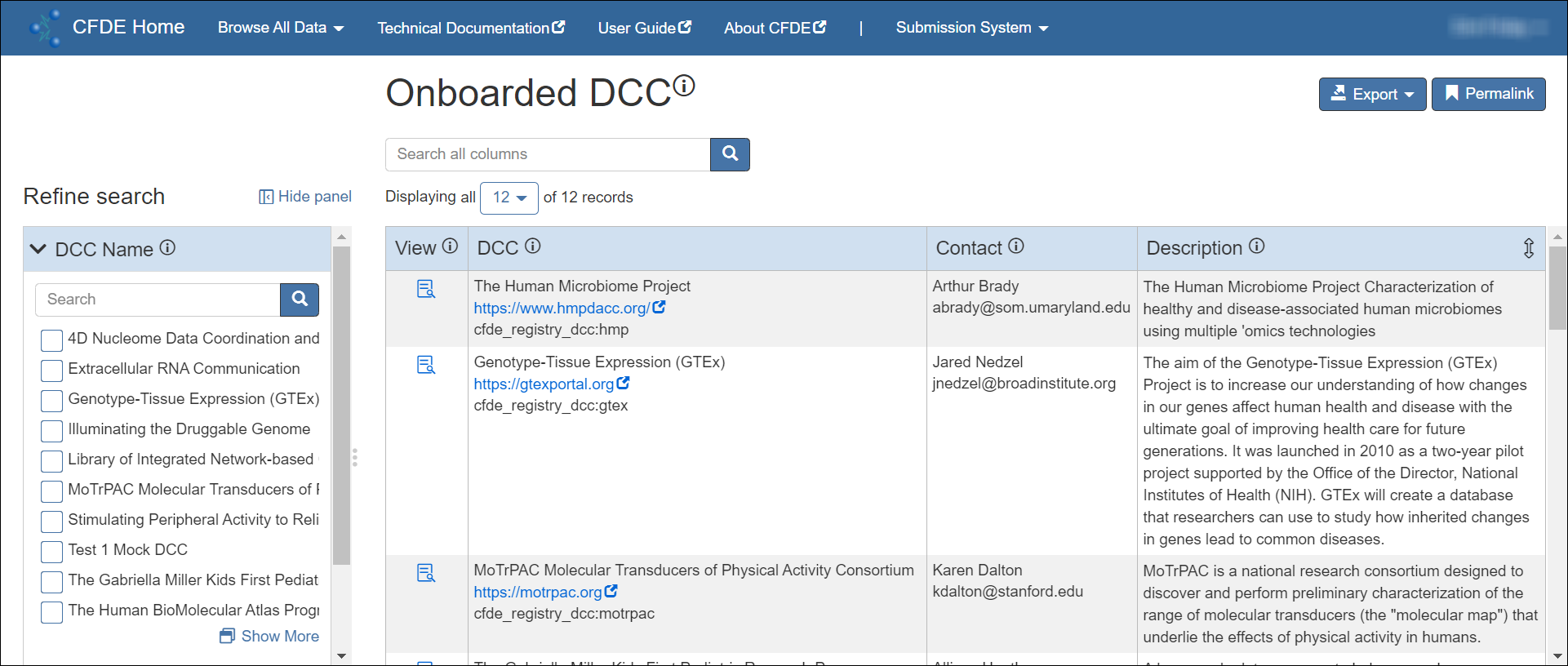
-
The data browser includes the following columns in the results table:
- View – Click the icon next to the appropriate record to view more information about the record. See the View Details section for more information.
- DCC – The name of the DCC enrolled/onboarded with the CFDE-CC.
- Contact – The primary contact’s name and email of the DCC.
- Description – A long description of the DCC’s purpose and data researched.
- The results can be filtered using the Refine Search filter panel. See the Refine Search Results section for more information. The panel includes the following facets by which you can filter the results:
- DCC Name
- Contact Name
- Contact Email
Review Enrolled Groups¶
To review the enrolled/registered groups:
-
Select the Submission System > Enrolled Groups option in the main menu bar of the Data Review system. The Registered Group page displays.

-
The data browser includes the following columns in the results table:
- View – Click the icon next to the appropriate record to view more information about the record. See the View Details section for more information.
- ID – The globally unique identifier for the group.
- Name – A short label for the enrolled/registered group.
- Description – A long description of the group.
- The results can be filtered using the Refine Search filter panel. See the Refine Search Results section for more information. The panel includes the following facets by which you can filter the results:
- ID
- Name
- Description
- DCC Group Role
Review Releases¶
To review the CFDE releases:
-
Select the Submission System > Releases option in the main menu bar of the Data Review system. The CFDE Release page displays.
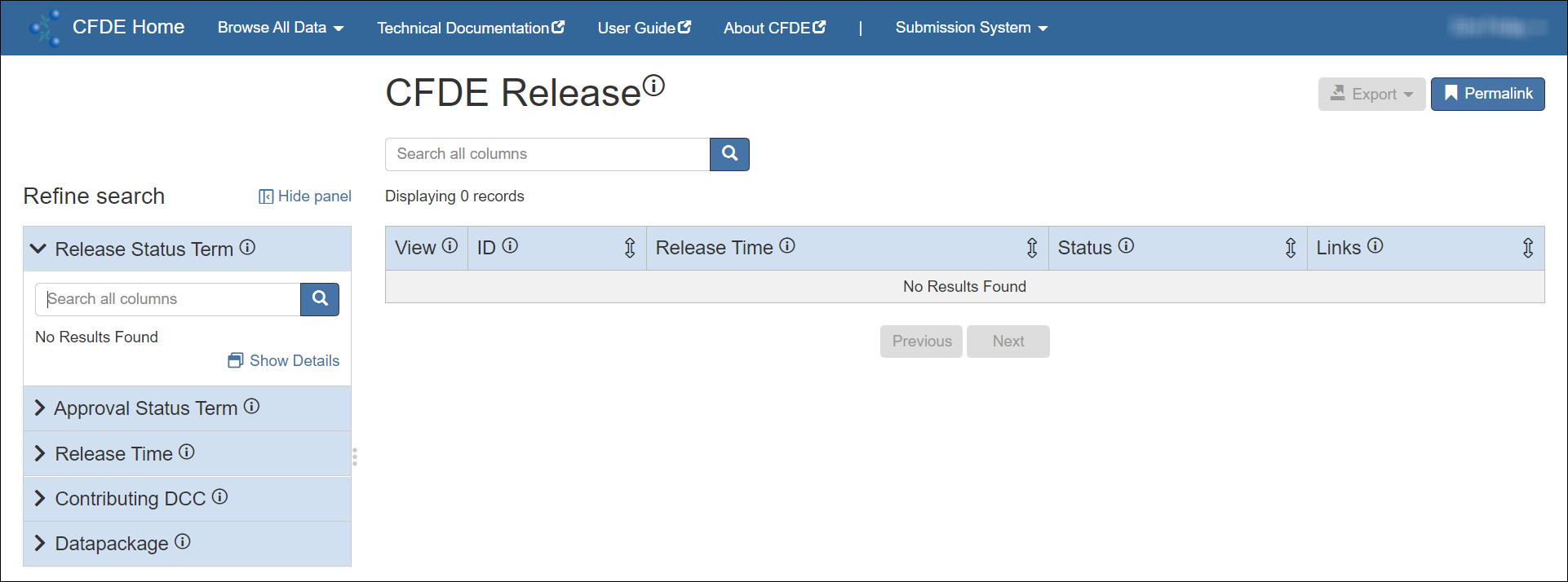
-
The data browser includes the following columns in the results table:
- View – Click the icon next to the appropriate record to view more information about the record. See the View Details section for more information.
- ID – The identifier for this release issued by the CFDE-CC for internal use.
- Release Time – A timestamp for when the release was completed by the CFDE-CC.
- Status – The status of this release in the submission system.
- Links – The URL of the ERMrest (an entity-relationship data storage service) catalog with the release content.
- The results can be filtered using the Refine Search filter panel. See the Refine Search Results section for more information. The panel includes the following facets by which you can filter the results:
- Release Status Term
- Approval Status Term
- Release Time
- Contributing DCC
- Datapackage
Review Vocabulary¶
To review the vocabulary:
- Select the Submission System > Vocabulary option in the main menu bar of the Data Review system.
- Select an item from the list:
- Release Status
- Datapackage Status
- Table Status
- Approval Status
- Group Role The data browser displays the CFDE data and filters related to the vocabulary term.
- The data browser includes the following columns in the results table:
- View – Click the icon next to the appropriate record to view more information about the record. See the View Details section for more information.
- ID – The globally unique identifier for the status concept.
- Name – A short label for the status concept.
- Description – A long description of the status concept.
- The available filters in the Refine Search panel vary based on the vocabulary term selected. See the Refine Search Results section for more information on how to filter the results.
Approve Data¶
Data can only be approved (or rejected) by users with Approver permissions.
To approve submitted data:
After logging in, you can view your personalized dashboard that includes saved searches and saved favorites for CF Programs, Anatomy, Assay, Disease, Taxonomy, Data Type, and File Format facets.

To populate the personalized dashboard: * Saved searches – Browse data under the Data Browser menu and select Saved Searches > Save current search criteria from the upper-right of the page. See the Save Searches section for more information. * Favorites – Browse data under the Data Browser menu and select the star icon next to an item in the Refine Search filter panel facet. See the Add Favorites section for more information.
The chart at the bottom of the personalized dashboard can be filtered by DCC (the checkboxes on the right) and grouped by anatomy, assay, CF program, data type, disease, ethnicity, race, sex, or species (the X-axis drop down). You can also change the Y-axis to display file count, data volume, collection count, sample count, or subject count. The Scale can be adjusted for Linear or Logarithmic rendering.
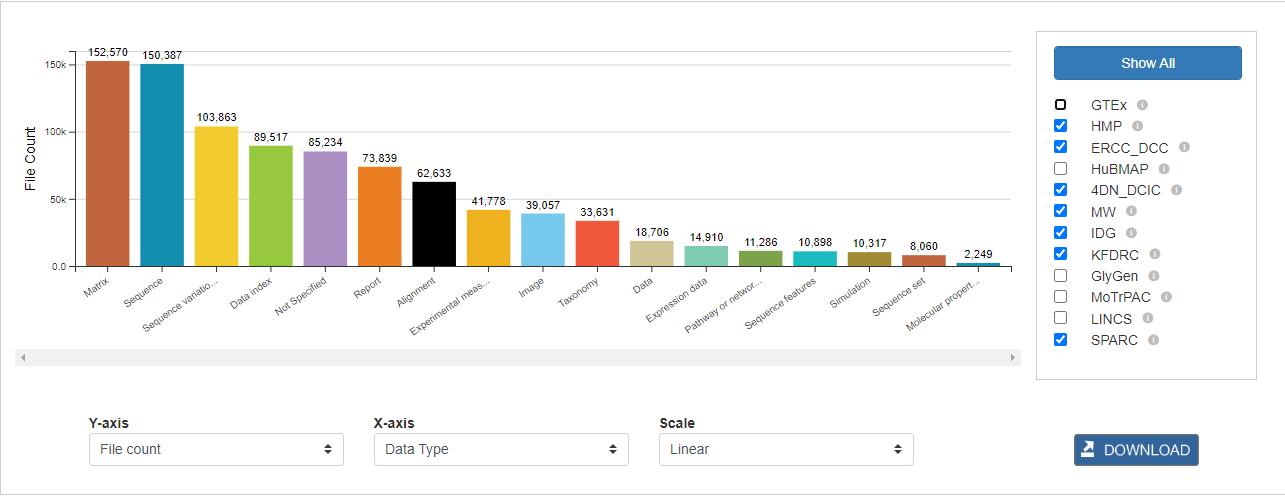
Data Submission¶
The Data Submission section is for data administrators to submit, review, and approve the data before being incorporated into the portal. This requires advanced permissions and is therefore not discussed in this User Guide. Please see the CFDE wiki for more information on how to submit, review, and approve data.